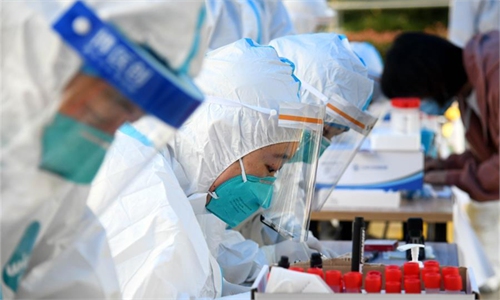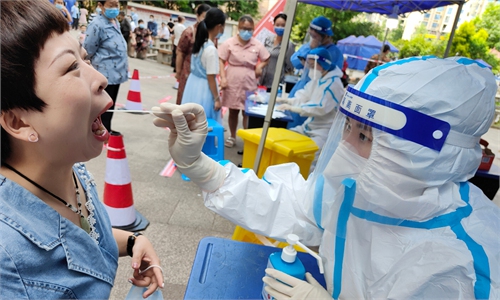Study of Omicron infections in Shanghai outbreak shows zero severity rate among non-risk group

The largest makeshift hospital in Shanghai, renovated from National Convention & Exhibition Center (Shanghai), is delivered on April 9, 2022 and could provide up to 50,000 beds. Photo: Xinhua
A new study has given the first comprehensive description of non-severe COVID-19 patients without unstable medical conditions, who accounted for over 95 percent of all cases during the Shanghai outbreak, and it shows that focusing medical resources fully and precisely on the vulnerable population can minimize the risk of overwhelming the regional medical system.
Since the identification of the Omicron variant in November 2021, the strain has become the main one causing infections across the world, with cases increasing exponentially in multiple countries. The high transmissibility of the Omicron variant has placed a huge burden on healthcare resources, although the vast majority of cases are not severe.
A large cohort study led by China's top epidemiologist Zhang Wenhong and conducted by the National Medical Center for Infectious Diseases of Huashan Hospital affiliated with Fudan University and the Shanghai Key Laboratory of Infectious Diseases and Biosafety Emergency Response between March 22 and May 3, 2022 at four Shanghai hospitals - Huashan Hospital, Shanghai Sixth People's Hospital, Shanghai Ninth People's Hospital and Shanghai Fourth People's Hospital - during the Omicron outbreak describes the spectrum of clinical features, risk factors for progression, and dynamic changes in viral load among initially non-severe Omicron-infected patients.
The study was published in the China CDC Weekly on Saturday.
Affected by the global spread of Omicron, Shanghai had reported 58,104 confirmed patients and 591,506 asymptomatic infections as of Sunday. Under the policy of "all those in need have been tested, and if positive, have been quarantined, hospitalized, or treated" in China, all silent carriers, mild cases and average cases received centralized treatment.
Analysis of the overall clinical profile, severe rates and prognosis of the huge number of non-severe Omicron infections in the Shanghai outbreak are critically important to public health policies, including hospitalization and treatment strategies during the pandemic.
All 33,816 participants enrolled in the study were diagnosed with non-severe COVID-19 infections upon hospital admission. They either had no underlying diseases or had underlying diseases but were in stable medical condition.
According to the study, coughs and sputum production were the most common symptoms among the non-severe patients, followed by fatigue and fever. The median symptom persistence was seven days. The average viral shedding time (VST) was six days.
Being older, having comorbidities and being initially symptomatic were associated with longer VSTs, while full vaccination and booster vaccinations were associated with shorter VSTs.
In the entire cohort, 22 patients developed severe/critical infections. All were in the risk group of patients aged above 60, who had stable underlying medical conditions (including cardiovascular disease, diabetes mellitus, lung disease, hepatic disease, cerebrovascular disease, or kidney disease) or an immunodeficiency condition such as a human immunodeficiency virus infection.
The severity rates among all subjects and risk-group subjects were 0.065 percent and 0.238 percent, respectively. The severity rate of the non-risk group turned out to be zero.
The author of the study said it had at least three limitations. First, the study only enrolled non-severe, stabilized Omicron patients and therefore could not describe the overall clinical spectrum of Omicron infections, especially severe Omicron infections. Therefore, the study reflected the clinical manifestations and outcomes of relatively healthy Omicron-infected patients. Second, not all patients received CT scan and laboratory tests. Third, all symptoms were self-reported, potentially introducing bias.
The study shows that older age, lack of vaccination and having multiple underlying conditions increased the risk of progression to severe/critical illness, which means that even among those having non-severe infections, there are still people who are vulnerable to the Omicron variant.
Thus, precise prevention and control should be carried out for vulnerable groups to reduce the fatality rate of those groups and reduce the harm of Omicron to a lower level.
The study provides evidence for refining COVID-19 public health strategies to minimize the risk of overwhelming regional medical resources by accurately assessing the severe disease rates of Omicron in different population groups.
It suggested that it is likely to significantly and gradually reduce the rate of severe illness and fatality among vulnerable populations if protective measures are taken, including full vaccination coverage, adequate special protection for vulnerable groups during the epidemic period, and their immediate access to medical treatment as soon as possible after infection.
If medical resources are fully and precisely focused on the vulnerable population and appropriate basic medical support is provided to the non-vulnerable group, medical resources will be optimized, and the diagnosis and treatment of non-COVID-19 diseases will not omitted due to COVID-19 outbreaks, the study noted.
Global Times



